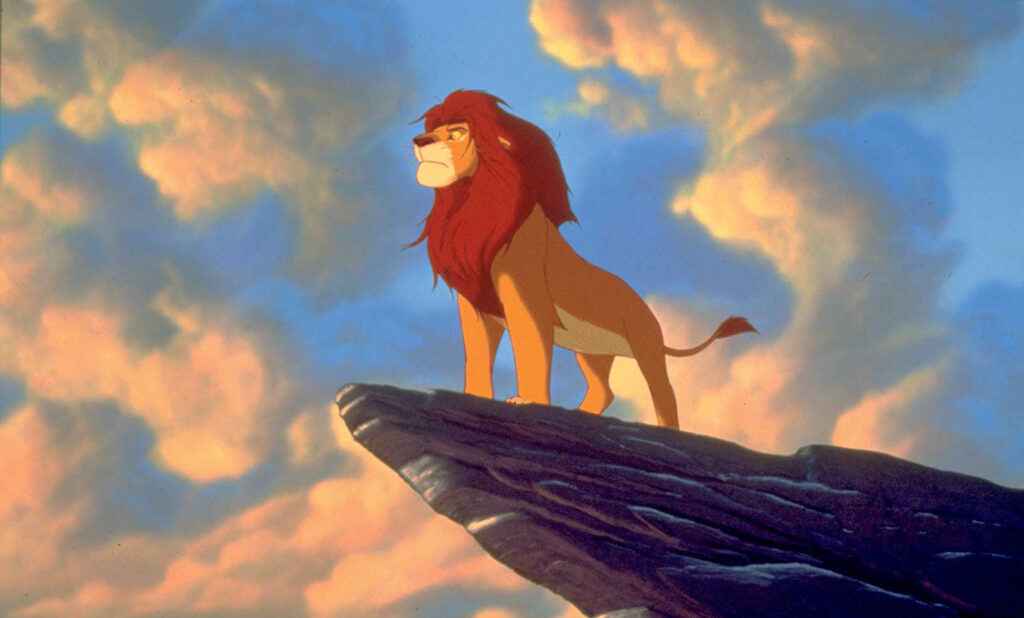Review THE LION KING by Disney
We are reviewing the Disney full-length animated features in order. At last we come to the crown jewel of the Disney Renaissance THE LION KING (1994).
Breaking all box office records for an animated film, earning half a billion dollars in ticket sale, winning two academy awards, this film is a cherished treasure of young children and old critics alike.
It had been many years since I saw this film last and was shocked to see how much better it was than I remembered. Experience, perhaps, has sharpened taste or wit, so I can now savor genius.
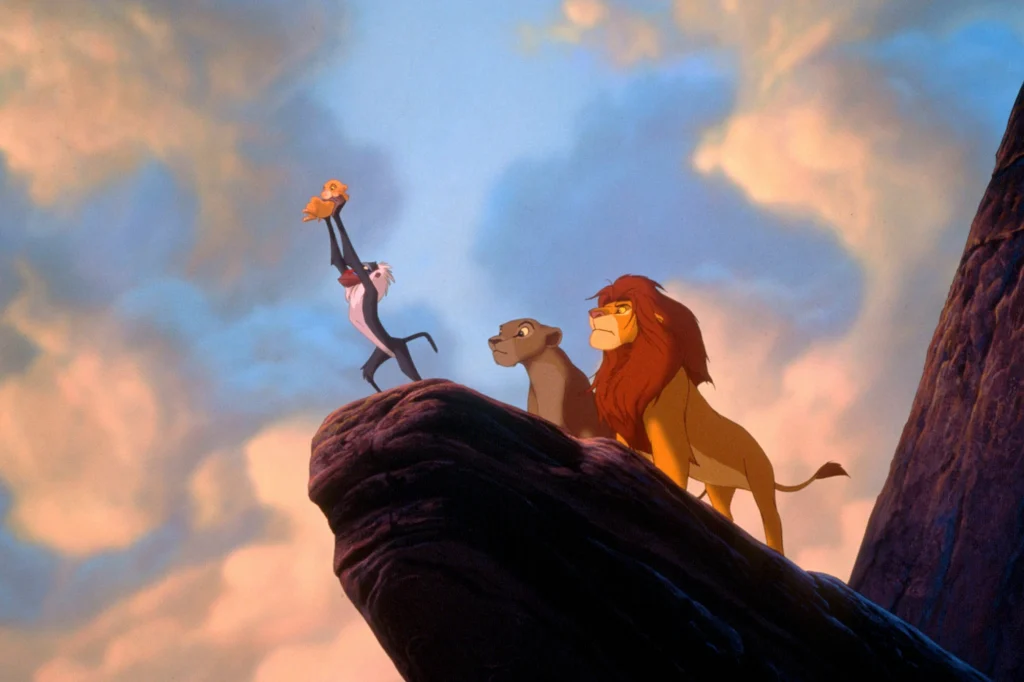
This film is the culmination and combination of the best of Disney, the sum of all their hard-earned craftsmanship over decades. Imagine music from ALADDIN, the landscapes from RESCUERS DOWN UNDER, the humor of BEAUTY AND THE BEAST, the breathtaking beauty and technical complexity of the spring rain sequence from BAMBI, the perfect capture of look and motion of animal life and a wonders of nature that runs throughout the Disney canon, and the straightforward but heartfelt elegance of script as seen on SNOW WHITE, and, yes, even the a stampede and murder as full of terror as the Night on Bald Mountain sequence from FANTASIA.
Additionally, the direction and camera work showed a craftsmanship superior even to other Disney films, with panning shots, circular shots, and expert use of slow motions or rapid cuts, as might be seen in THE MATRIX by the Wachowsky Brothers, but seamlessly unobtrusive.
They even animated a dolly zoom into a close up, to give certain shots extra force and drama. The elan and craftsmanship to do such a thing so smoothly and masterfully with pen and ink is truly startling.

There are other films one might prefer for personal reasons of taste or artistic judgment, but in terms of plot, pacing, craftmanship, musical adornment, clarity and depth of storytelling, nobility of theme, this is Disney’s masterpiece.
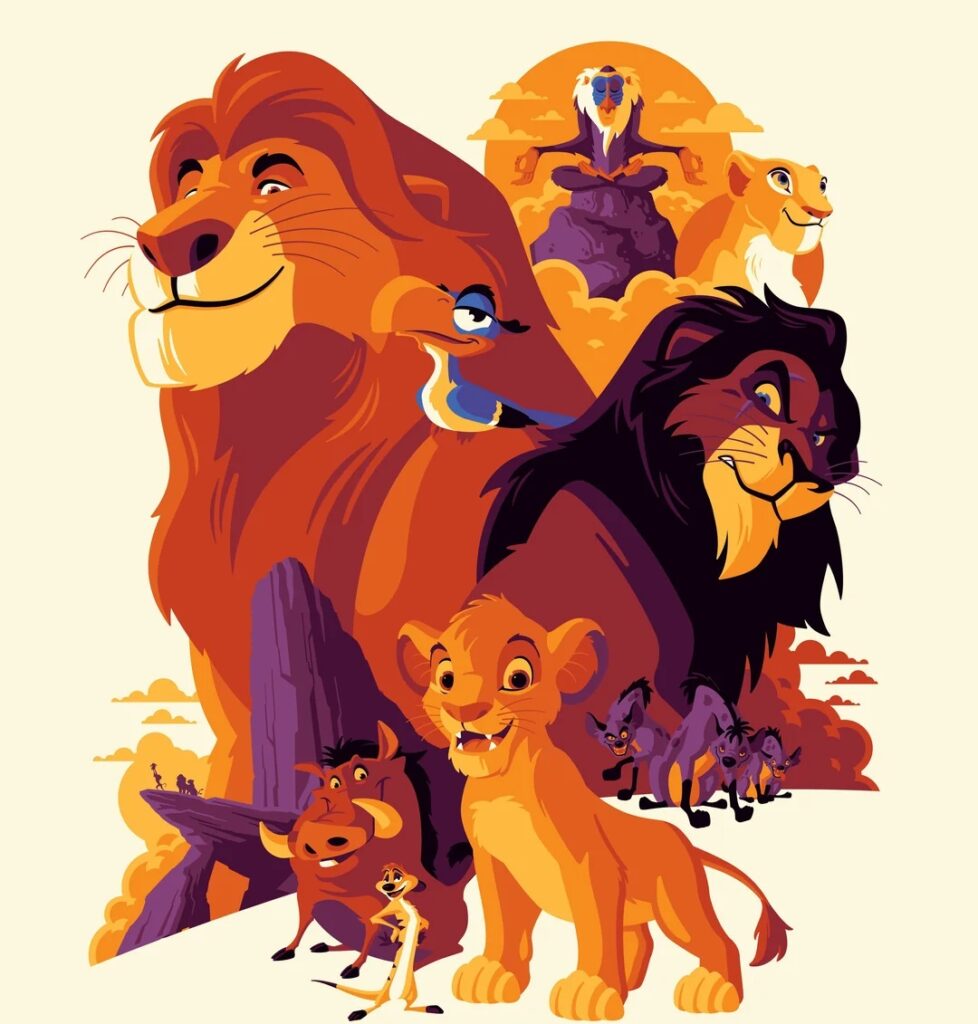
The film is the tale of Simba (Matthew Broderick), son of Mufasa (James Earl Jones), king of lions, whose scheming uncle Scar (Jeremy Irons) conspires against them. Scar encompasses the murder of his liege and brother with the aid of outlaw hyenas (Whoopi Goldberg and Cheech Marin). Simba, thought dead, flees into exile.

Tricked into blaming himself for his father’s death, Simba grows to manhood in orphaned idleness with two slackwit loafers, a warthog and a meercat, until his childhood friend, now a sleek lioness, hunting ever farther abroad to escape the starvation unleashed by the usurper’s reign, confronts, fights, then recognizes him.
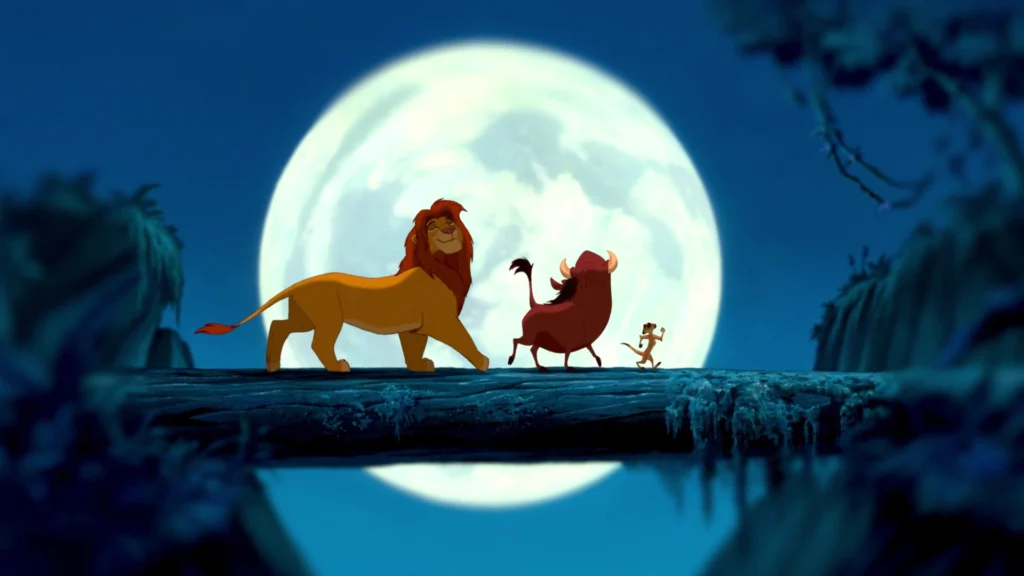
Simba is persuaded to return to his rightborn duty by a shaman simian Rafiki (Robert Guillame) and a mystic vision of his father in heaven. He returns to the pridelands to confront and overthrow his uncle. The film ends as it began with the birth of Simba’s son, the next prince, completing the circle of life.
First, let me compliment the clarity of the story. It is simple and elegant, like a myth, and needs nothing more than the most straightforward of motives for the characters: the king is noble, strong and good and loves his son; his willful son is traumatized by evil events and shattered, but returns in strength to resume his royal duty; the evil uncle is sly and supercilious; the hornbill majordomo is officious and punctilious; the hyenas are craven bullies.
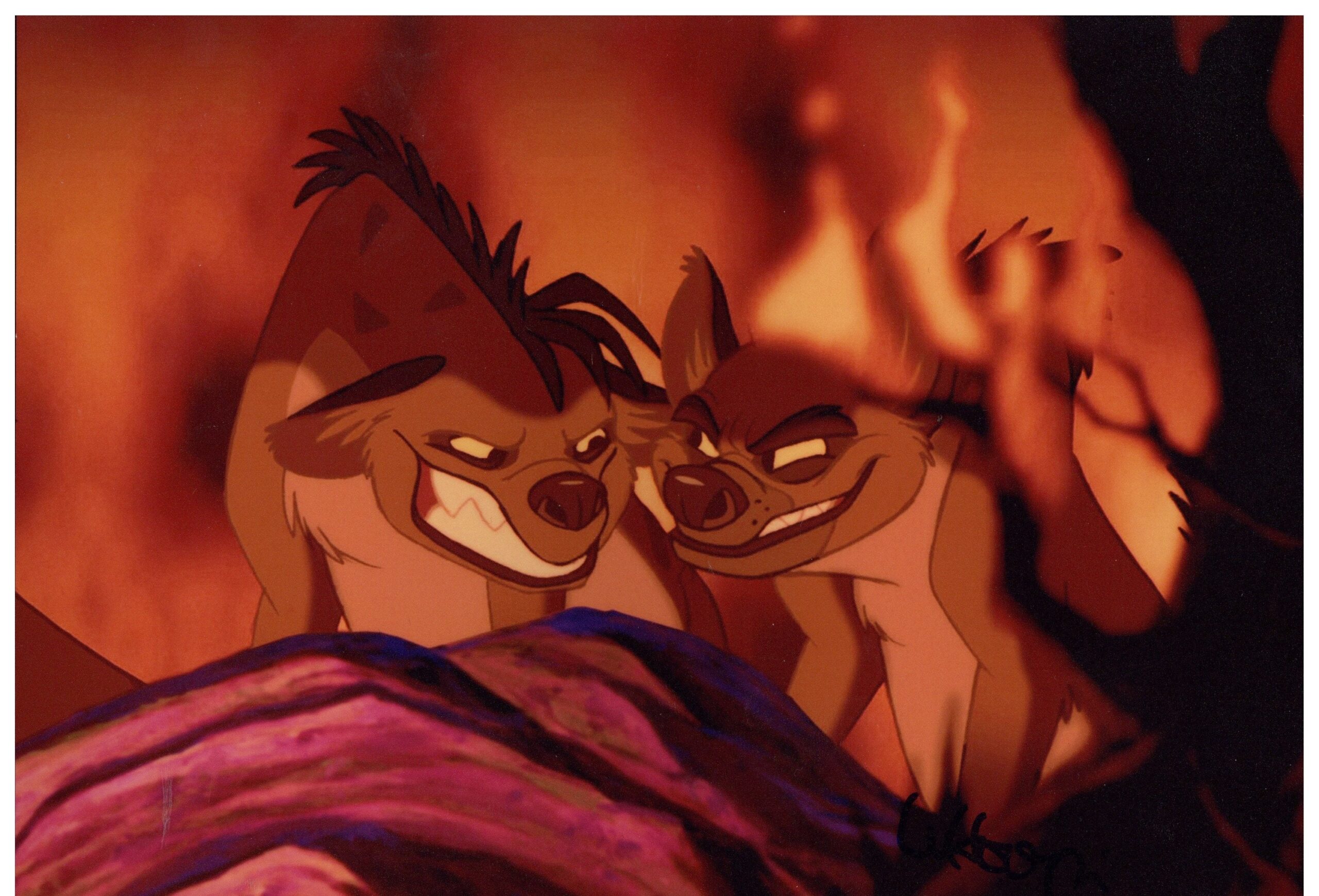
What is blissfully absent is any trace of doubt about Simba’s right to reign and rule. To be sure, his misplaced guilt over this father’s death makes him unwilling to be king for all his youth, but nothing implies he is unable to be king: the office his right and royal duty. Compare this with the self-doubt of reluctant heroes, seen too frequently in modern films, who mope that they may lack the ability to rule or the even right to do so. Not here.
The natural hierarchy is assumed as right and good, part of the circle of life, and the King explicitly says each beast has its part to play from highest to lowest. There is a fairytale purity to the assumption at odds with modern egalitarianism, which is refreshing.
Also absent is any trace of comic absurdity of the villain. Scar is subtle, witty, cruel, cold, and tyrannous. He is not the selfish butler from the ARISTOCATS, nor thumb-sucking buffoon from ROBIN HOOD. Scar scares. When he dies, it is from the very evils he himself set in motion: the brutal end (not shown on screen) is poetic justice.
The hero is heroic, and the villain is full of villainy.
Each character is characterized immediately upon his introduction, both in the drawing of face and body language, and in the expert voice acting, but also the cleverness and brevity of the dialog.
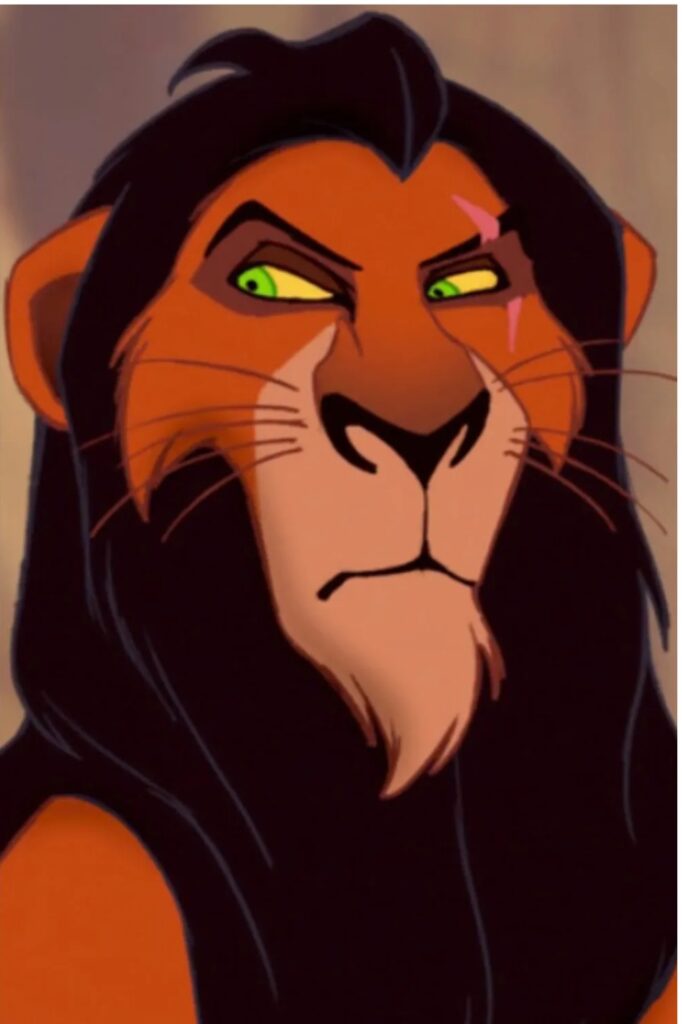
One droll line from Scar is all that is required to confirm him as a hateful self-pitying traitor, pompous, proud and craven. James Earl Jones, as the voice of Mufasa, cannot help but sound kingly, and, again, only two or three lines are needed to show his majesty, as he explains the burden and glory of kingship to his son.
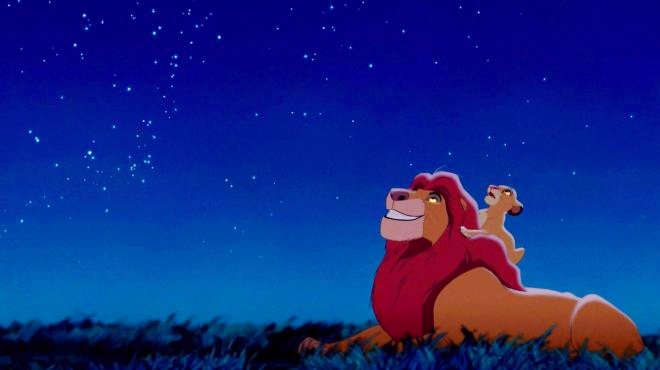
The evil of Scar is emphasized by the playful goodfellowship of his cub nephew, as the uncle manipulates him into a dangerous venture where murderers await. The unctuous drawl of Jeremy Irons is at his most hateful, patronizing, venomous. Again, the dialog is brief and to the point.
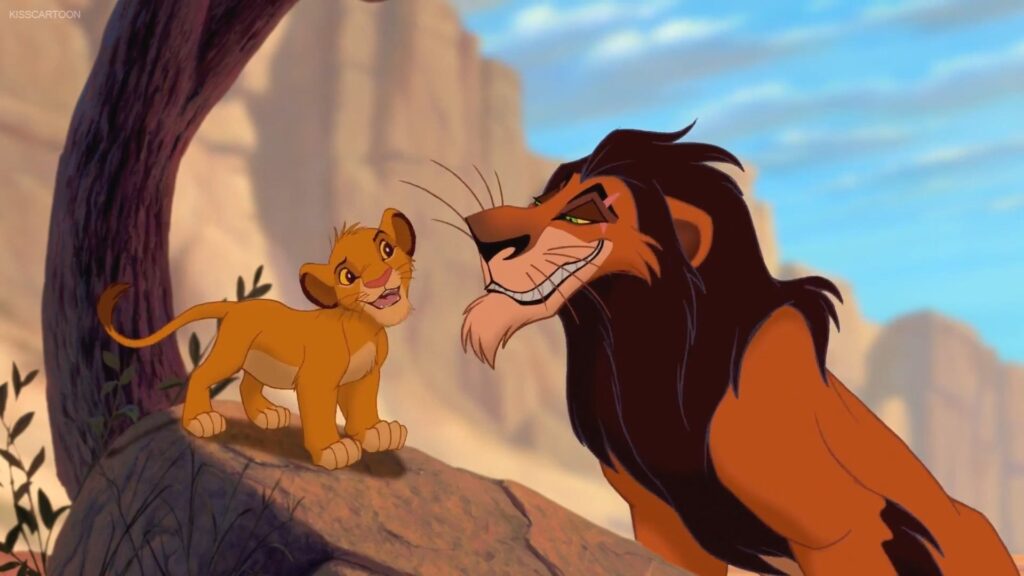
Indeed, the opening sequence needs no dialog at all, nor does the ending, when the beasts of all kinds and kindred gather to bow and give fealty to the newborn prince.
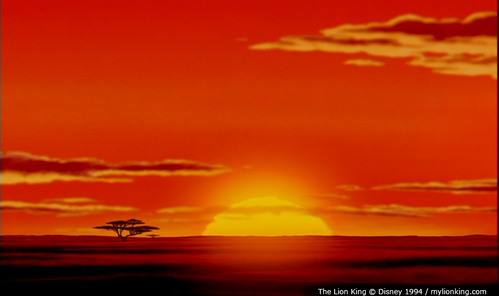
The opening, from the opening wail accompanying a sunrise over tropical savanna to the final crash of drums leading to the stark black field on which the movie name is blazoned in red letters, is an exquisite display of every aspect of cinematography, music, and animated draftsmanship. The came focuses from ants bearing leaf marching along a treebranch to zebra cavorting and trotting below.

A whole Noah’s ark of animals are lovingly drawn and set in motion by animators who studied their subjects. Similar sequences of hosts of beast and bird of water and land adorn other Disney works, but this set-piece is their masterwork.
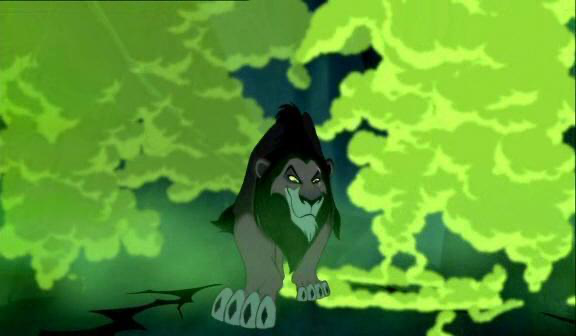
Changes of the color palette during the song and dance sequences are simply amazing, verging on the psychedelic. The whole scene will swim with pastels as beasts dance in complex kaleidoscope symmetry, or turn black with sudden fear, of ghastly green with envy, or volcano red with rage.
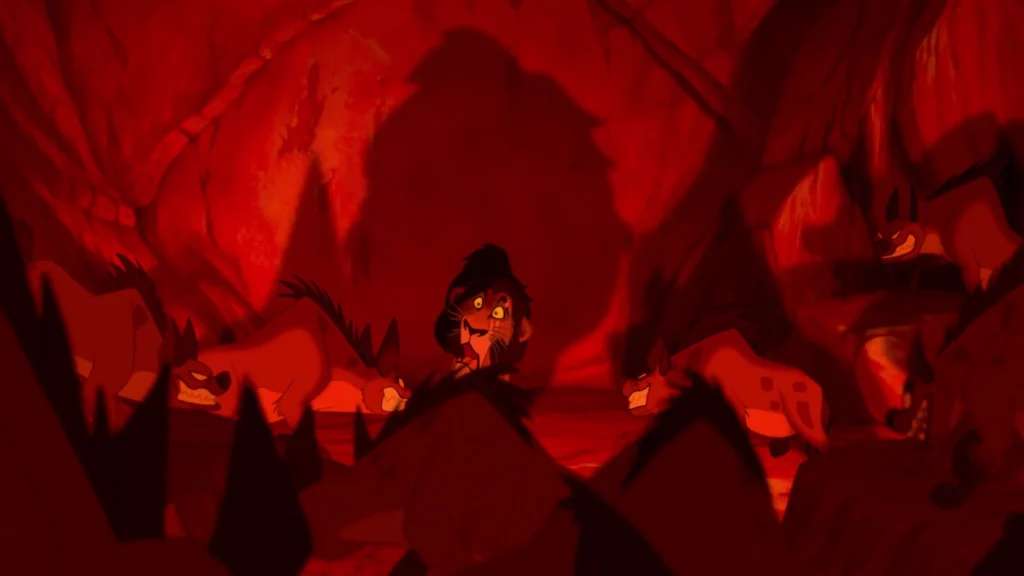
Thankfully these exuberant virtuoso displays of color and lighting, music and dance avoid the freakishness of other Disney excesses, such as, for example, the drunk Pink Elephant dream sequence in DUMBO, or the Heffalump dream sequence in WINNIE THE POOH.
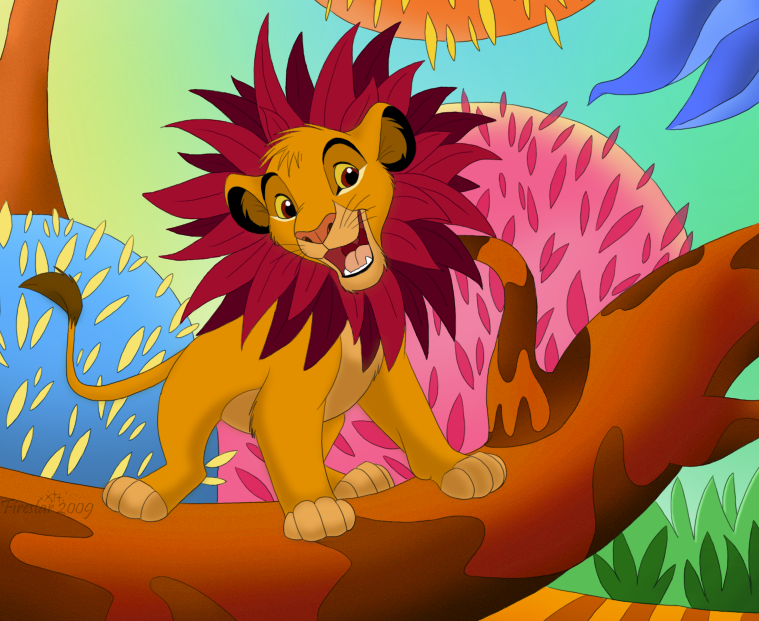
Unlike the singing poodle voiced by Bette Midler in OLVIER AND COMPANY, the songs are actually memorable, as where the young prince sings of the glories of being king, or as where the villain’s song as Scar harangues his goose-stepping hyena minions. We must perhaps wait for HUNCHBACK OF NOTRE DAME for a villain song as dire, stark, and gripping.

It might be easy to overlook “The Morning Report” song, where the fussy hornbill bird Zazu in many a double meaning and wry pun tries to tell King Mufasa the state of the kingdom. The lyrics are hard to make out, because Mufasa (and the audience) is distracted by Simba’s childhood attempts to learn to roar and pounce as a proper lion should. But the wit of the lyricist merits attention
It’s an honor and a privilege, a duty I perform
With due sense of decorum and with pride
With deference and great respect very much the norm
Plus a hint of sycophancy on the side
Chimps are going ape
Giraffes remain above it all
Elephants remember
Though just what I can’t recall
Crocodiles are snapping up
Fresh offers from the banks
Showed interest in my nest egg
But I quickly said, “No thanks!”
We haven’t paid the hornbills
And the vultures have a hunch
Not everyone invited will be
Coming back from lunch
The buffalo have got a beef
About this season’s grass
Warthogs have been thwarted
In attempts to save their gas
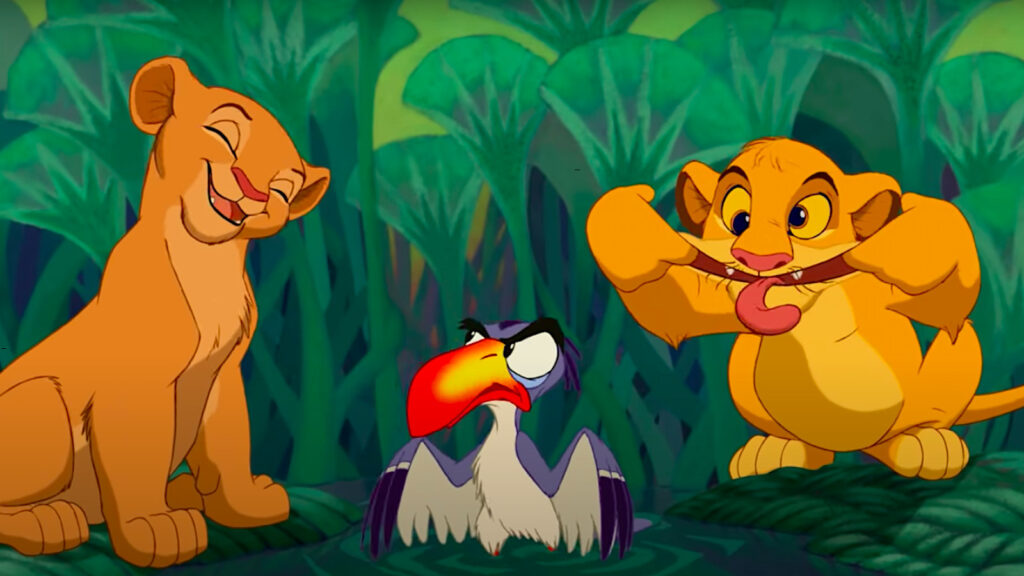
The cleverness of lyrics is repeated during the love song (composed by Elton John, with lyrics by Tim Rice), when Timon and Pumbaa sing comical lyrics to the same song, not about love, but about how a dame is going to break up their comfortable guy gang.
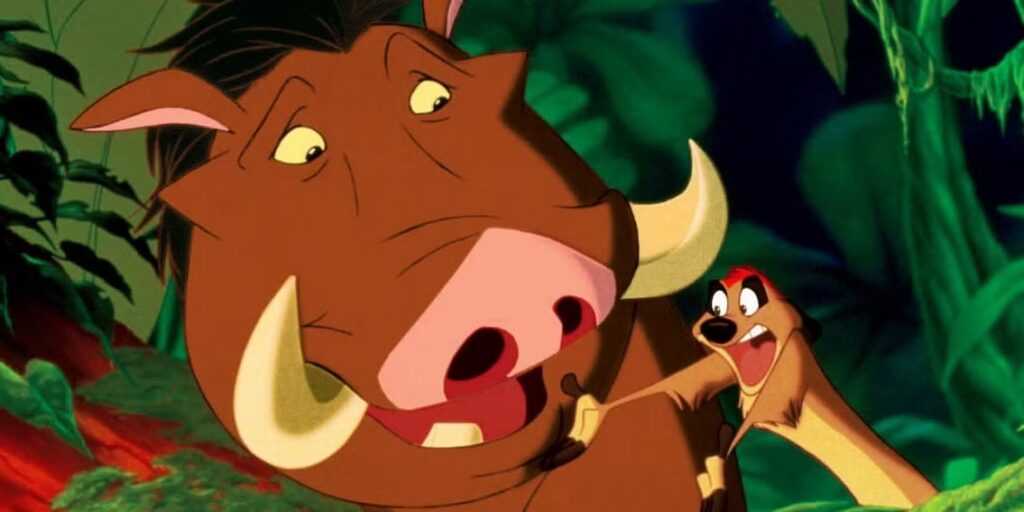
There is some slapstick humor, which normally I do not enjoy, mostly Simba pranking the hornbill, and one too many passing gas jokes — including a song stanza devoted to that theme — which I never enjoy. Except the wisecrack about stars being balls of gas, which I enjoyed.
The film mimics some themes from BAMBI, particularly in the opening and ending showing the parallel birth of father and son, interrupted by the tragic death of a parent, but where BAMBI wanders from point to point, as does the book on which it is based, as a series of vignettes, the plot of LION KING is tightly woven, with no wasted scenes, no excess speechifying, no songs intruding merely for the sake of a song, no unused characters.
The film delights in clever parallels of theme which I, for one, did not notice when I saw this in my youth. Disney is expert at making, not children’s films, which are mean for children only, but family films, able to please both young and old.
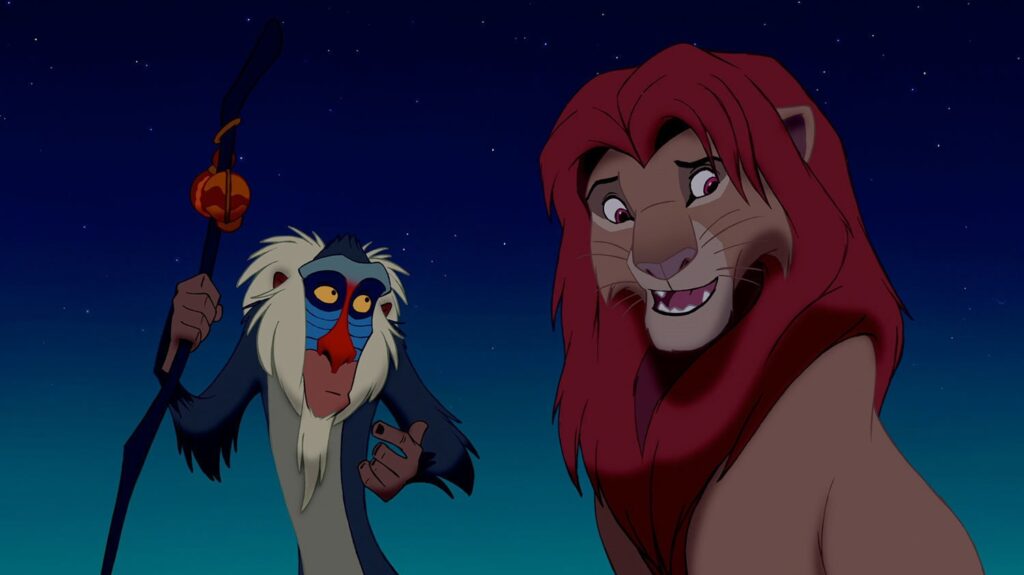
The theme in this film also introduces a supernatural aspect, a sense of unity between earth and heaven, rare in modern films, particularly the statement that stars are the ancestral kings looking down from heaven, and that the prince bears not merely the face, but also the spirit and duties of his dead father. This is emphasized when Rafiki, the mystic Mandrill, shows Simba his reflection, first in the water, than as his father’s ghost amid the storm clouds. When Simba approaches the usurper in the midst of the desolation of his misrule, at first Scar thinks he sees a ghost, and believes it is Mufasa.

Simba, as befits a merciful king, spares Scar’s life, but, ironically, sentences him to exile with the same words Scar used to exile him. They fight in slow motion, and, befittingly, the moves and strikes are those of real lions, magnificent to behold.
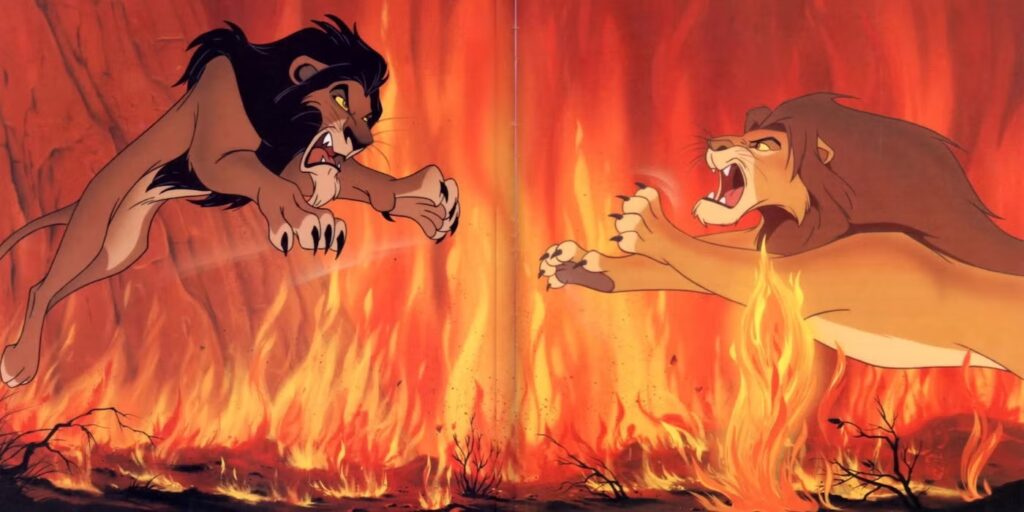
Scar attempts to betray, and wheedle, and shift blame, and so on, but to no avail. When Scar clings to a cliff at Simba’s mercy, it is in the same posture that Mufasa clung to the cliff when Scar showed no mercy.

It should be mentioned that the comedy relief sidekicks, albeit understanding nothing of what is going on, volunteer to aid and assist in the assault on the usurper, acting as comical bait in drag, and singing a goofy song — but the warthog does indeed defeat foes in a burst of comical rage.
As in SLEEPING BEAUTY, the prince is told his wife has been pre selected for him, and the child turns up his nose at this idea. As in BAMBI, the childhood playmate of innocent youth becomes the lover and mate of the hero as he matures.
One subtlety is that Nala is a better wrestler than Simba, and she always pins him when they playfully fight as children. When they meet again as adults, and stranger to each other, Simba defends his slackwit slacker friends from being foodstuffs, and she manages to pin him, and at this moment they recognize each other. But then when they fall in love, he pins her, and she gazes up at him with a very feminine expression of love longing.
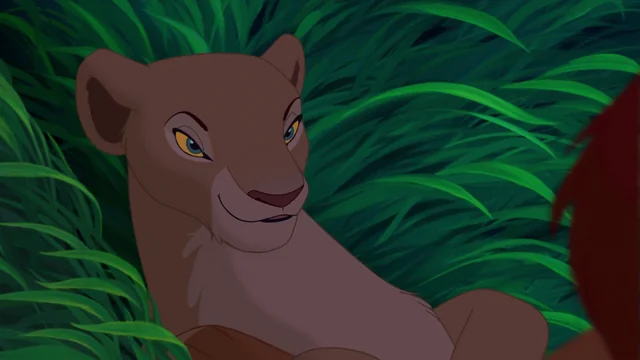
But the love story is not the central tale, as it might have been in a Disney princess film. No, this story is a simple and deeply felt tale of hope and loss, grief and guilt, duty and salvation. The world is held in an order, and passes rightly from father to son, each beast in his place; ambition and wickedness through the world out of balance, and the streams run dry, the game migrates, the grass dies, and the countryside is blasted and sick. With the return of the king, rightful rule is returned, the evildoers perish or flee, and all things are restored.
There are other Disney films I myself enjoy more, but none are better crafted, or show such genius of writing, draftsmanship, scenery and direction.
This film is the crown jewel of many Disney treasures. It may well be the apex of their art.
